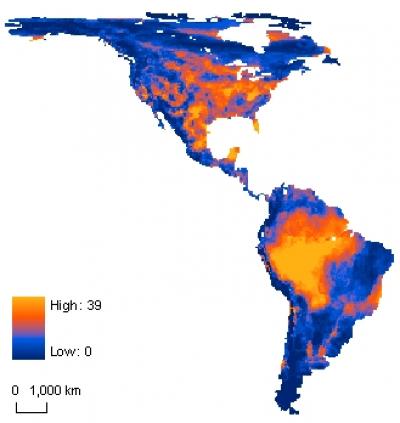Some Mammals Too Slow To Escape Climate Change

Some mammals just can't move fast enough to outrun climate change, a new study suggests. And highways and shopping malls may hold them back even more.
As greenhouse gasses increase the temperature of the earth, the climate in the Western Hemisphere will be changing drastically, and mammals in North and South America will have to move to new habitats that are more hospitable. Some will make it and some won't, the new research suggests.
The researchers found in a paper published May 14 in the journal Proceedings of the National Academy of Sciences, that a safe haven could be out of reach for 9 percent of the Western Hemisphere's mammals, and as much as 40 percent in certain regions, because the animals just won't move swiftly enough to outpace climate change.
"Our figures are a fairly conservative — even optimistic — view of what could happen because our approach assumes that animals always go in the direction needed to avoid climate change and at the maximum rate possible for them," study researcher Josh Lawler, of the University of Washington, said in a statement.
Moving mammals
For the past decade scientists have outlined new areas suitable for mammals likely to be displaced as warming changes their current habitat. This is the first look at if mammals will actually be able to get to those new areas. The analysis looked at 493 mammals in the Western Hemisphere.
The research built on previous work by Lawler that reveals areas with climates needed by each species, and climate change information from 10 global climate models and a mid-high greenhouse gas emission scenario developed by the United Nation's Intergovernmental Panel on Climate Change.
Sign up for the Live Science daily newsletter now
Get the world’s most fascinating discoveries delivered straight to your inbox.
The researchers coupled how swiftly a species is able to disperse across the landscape with how often its members make such a move. In this case, the scientists assumed animals would move between habitats each generation.
Selected species
More than half of the species previously projected to expand their ranges in the face of climate change will actually see their ranges contract because the animals won't be able to expand into new areas fast enough, the researchers said.
Small primates like tamarins and spider monkeys — some of which are already considered threatened or endangered — will be hard-pressed to outpace climate change, they found. Nearly all the hemisphere's primates will experience severe reductions in their ranges, on average about 75 percent.
On the other hand, large mammals like coyotes, caribou and anteaters will be able to make the move. For example, some species with high dispersal rates in areas with slower-paced climate change are expected to expand their ranges.
Human obstacles
The researchers were conservative in taking into account human-made obstacles such as cities and crop lands that animals encounter, they said. For the analysis they didn't take into account transit time if animals must go completely around human-dominated landscapes.
"In the past when climates have changed — between glacial and interglacial periods when species ranges contracted and expanded — the landscape wasn't covered with agricultural fields, four-lane highways and parking lots, so species could move much more freely across the landscape," Lawler said.
Study researcher Carrie Schloss, also of the University of Washington, agreed: "Conservation planners could help some species keep pace with climate change by focusing on connectivity — on linking together areas that could serve as pathways to new territories, particularly where animals will encounter human-land development."










